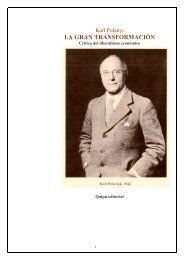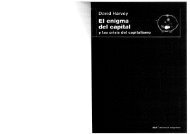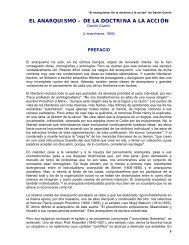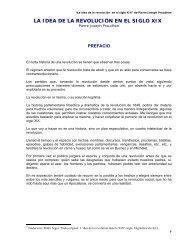- Page 1 and 2:
Karl R. Popper LA LÓGICA DE LA INV
- Page 3 and 4:
A MI ESPOSA, a quien se debe que ha
- Page 5 and 6:
Sumario Páginas Nota del traductor
- Page 7 and 8:
75. Una reinterpretación estadíst
- Page 9 and 10:
Las teorías son redes : sólo quie
- Page 11 and 12:
No hay nada más necesario para el
- Page 13 and 14:
Prefacio de la edición inglesa 17
- Page 15 and 16:
Prefacio de la edición inglesa 19
- Page 17 and 18:
Prefacio de la edición inglesa 21
- Page 19 and 20:
Prefacio de la edición inglesa 23
- Page 21 and 22:
PRIMERA PARTE Introducción a la l
- Page 23 and 24:
CAPITULO PRIMERO Panorama de alguno
- Page 25 and 26:
Panorama de algunos problemas funda
- Page 27 and 28:
Panorama de algunos problema» fund
- Page 29 and 30:
Panorama de algunos problemas funda
- Page 31 and 32:
Panorama de algunos problemas funda
- Page 33 and 34:
Panorama de algunos problemas funda
- Page 35 and 36:
Panorama de algunos problemas funda
- Page 37 and 38:
Panorama de algunos problemas funda
- Page 39 and 40:
Panorama de algunos problemas funda
- Page 41 and 42:
Panorama de algunos problemas funda
- Page 43 and 44:
Panorama de algunos problemas funda
- Page 45 and 46:
Sobre el problema de una teoría de
- Page 47 and 48:
Sobre el problema de una teoría de
- Page 49 and 50:
Sobre el problema de una teoría de
- Page 51 and 52:
SEGUNDA PARTE Algunos componentes e
- Page 53 and 54:
CAPITULO TERCERO Teorías Las cienc
- Page 55 and 56:
Teorías 59 terprete la palabra «p
- Page 57 and 58:
Teorías 61 enunciados singulares a
- Page 59 and 60:
Teorías 63 Pero también es posibl
- Page 61 and 62:
Teorías 65 tos individuales son (n
- Page 63 and 64:
Teorías 67 mar la existencia de un
- Page 65 and 66:
Teorías 69 ápice del sistema; tal
- Page 67 and 68:
Teorías 71 aquél, entonces se con
- Page 69 and 70:
Teorías 73 Diré, incluso, que cie
- Page 71 and 72:
CAPITULO CUARTO La falsabilidad Me
- Page 73 and 74:
La falsabilidad 77 zonamientos dedu
- Page 75 and 76:
La falsabilidad 79 pre abierta— d
- Page 77 and 78:
La faliabilidad 81 mos que hemos ex
- Page 79 and 80:
La fahabilidtul 83 eión, es precis
- Page 81 and 82:
La falsabilidad 85 enunciados. Pero
- Page 83 and 84:
La falsabüidad 87 excluye o prohib
- Page 85 and 86:
CAPITULO QUINTO El problema de la b
- Page 87 and 88:
El problema de la base empírica 91
- Page 89 and 90:
El problema de la base empírica 93
- Page 91 and 92:
El problema de la base empírica 95
- Page 93 and 94:
El problema de la base empírica 97
- Page 95 and 96:
El problema de la base empírica 99
- Page 97 and 98:
El problema de la base empírica 10
- Page 99 and 100:
El problema de la base empírica 10
- Page 101 and 102:
El problema de la base empírica 10
- Page 103 and 104:
CAPITULO SEXTO Grados de contrastab
- Page 105 and 106:
(irados de contrastabilidad 109 en
- Page 107 and 108:
Grados de contrastahilidad 111 nota
- Page 109 and 110:
Grados de contrastabilidad 113 buir
- Page 111 and 112:
Grados de contrastabilidad 115 igua
- Page 113 and 114:
Grados de contrastabilidad 117 por
- Page 115 and 116:
Grados de contrastabilidad 119 cons
- Page 117 and 118:
Grados de contrastabilidad 121 Pero
- Page 119 and 120:
Grados de contrastabilidad 123 dime
- Page 121 and 122:
40. Dos MANERAS DE REDUCIR EL NÚ.M
- Page 123 and 124:
Grados de contrastabilidad 127 a to
- Page 125 and 126:
La sencillez 129 tido metodológico
- Page 127 and 128:
La sencillez 131 sencillez en la pr
- Page 129 and 130:
La sencillez 133 He puesto ya de ma
- Page 131 and 132:
La sencillez 135 parte, xina teorí
- Page 133 and 134:
CAPÍTULO OCTAVO La probabilidad Me
- Page 135 and 136:
La probabilidad 139 han planteado f
- Page 137 and 138:
La probabilidad 141 «puente» el t
- Page 139 and 140:
La probabilidad 143 las propiedades
- Page 141 and 142:
La probabilidad 145 de convergencia
- Page 143 and 144:
La probabilidad 147 Haremos ver aho
- Page 145 and 146:
La probabilidad 149 Una propiedad y
- Page 147 and 148:
La probabilidad 151 todos los eleme
- Page 149 and 150:
La probabilidad 153 de una sucesió
- Page 151 and 152:
La probabilidad 155 Una vez llegado
- Page 153 and 154:
La probabilidad 157 llegar a los ap
- Page 155 and 156:
La probabilidad 159 En el estudio q
- Page 157 and 158:
La probabilidad 161 Quizá ha de pa
- Page 159 and 160:
La probabilidad 163 sucesiones infi
- Page 161 and 162:
La probabilidad 165 mial, aquélla
- Page 163 and 164:
La probabilidad 167 bien expresar e
- Page 165 and 166:
La probabilidad 169 lo pequeño enc
- Page 167 and 168:
La probabilidad 171 a que las discr
- Page 169 and 170:
La prohabilidad 173 64. ELIMINACIÓ
- Page 171 and 172:
La probabilidad 175 que sea «absol
- Page 173 and 174:
La probabilidad 177 plícitamente
- Page 175 and 176:
La probabilidad 179 Una resuelta ap
- Page 177 and 178:
La probabilidad 181 «confirmado»,
- Page 179 and 180:
La probabilidad 183 límite frecuen
- Page 181 and 182:
La probabilidad 185 de estar franca
- Page 183 and 184:
La probabilidad 187 bilidad tan gra
- Page 185 and 186:
La probabilidad 189 físico atribui
- Page 187 and 188:
La probabilidad l9l mentos razonabl
- Page 189 and 190:
La probabilidad 193 No solamente no
- Page 191 and 192:
La probabilidad 195 aparece cierta
- Page 193 and 194:
La probabilidad 197 tanto, también
- Page 195 and 196:
La probabilidad 199 problema, espec
- Page 197 and 198:
CAPITULO NOVENO Algunas observacion
- Page 199 and 200:
Algunas observaciones sobre la teor
- Page 201 and 202:
Algunas observaciones sobre la teor
- Page 203 and 204:
Algunas observaciones sobre la teor
- Page 205 and 206:
Algunas observaciones sobre la teor
- Page 207 and 208:
Algunas observaciones sobre la teor
- Page 209 and 210:
Algunas observaciones sobre la teor
- Page 211 and 212: Algunas observaciones sobre la teor
- Page 213 and 214: Algujms observaciones sobre la teor
- Page 215 and 216: Algunas observaciones sobre la teor
- Page 217 and 218: Algunas observaciones sobre la teor
- Page 219 and 220: Algunas observaciones sobre la teor
- Page 221 and 222: Algunas observaciones sobre la teor
- Page 223 and 224: Algunas observaciones sobre la teor
- Page 225 and 226: Algunas observaciones sobre la teor
- Page 227 and 228: Algunas observaciones sobre la teor
- Page 229 and 230: Algunas observaciones sobre la teor
- Page 231 and 232: La corroboración 235 79. SOBRE LA
- Page 233 and 234: La corroboración 237 quedaría, de
- Page 235 and 236: La coTrohoTación 239 Pero, ¿podem
- Page 237 and 238: La corroboración 241 mos no pueden
- Page 239 and 240: La corroboración 243 A mi entender
- Page 241 and 242: La corroboración 245 81. LÓGICA I
- Page 243 and 244: La corroboración. 247 sión va má
- Page 245 and 246: La corroboración 249 No tengo obje
- Page 247 and 248: La corroboración 251 el hecho de c
- Page 249 and 250: La corroboración 253 ción» —qu
- Page 251 and 252: La corroboración 255 sentido de gr
- Page 253 and 254: La corroboración 257 sistema de en
- Page 255 and 256: La corroboración 259 pesor del dep
- Page 257 and 258: La corroboración 261 industriosame
- Page 259 and 260: http://psikolibro.blogspot.com APÉ
- Page 261: APÉNDICE I. Definición de dimensi
- Page 265 and 266: Cálculo general de la frecuencia e
- Page 267 and 268: Deducción de la primera forma de l
- Page 269 and 270: Un método para construir modelos d
- Page 271 and 272: APÉNDICE V. Examen de una objeció
- Page 273 and 274: Examen de una objeción. El experim
- Page 275 and 276: Sobre un procedimiento de medir no
- Page 277 and 278: APÉNDICE VII. Observaciones acerca
- Page 279 and 280: Observaciones acerca de un experime
- Page 281 and 282: NUEVOS APÉNDICES http://psikolibro
- Page 283 and 284: Aun cuando me he encontrado, con gr
- Page 285 and 286: APÉNDICE *I. Dos notas sobre induc
- Page 287 and 288: Dos notas sobre inducción y demarc
- Page 289 and 290: Dos notas sobre inducción y demarc
- Page 291 and 292: APÉNDICE *II. Nota sobre probabili
- Page 293 and 294: Nota sobre probabilidad (1938) 297
- Page 295 and 296: Nota sobre probabilidad (1938) 299
- Page 297 and 298: Empleo heurístico de la definició
- Page 299 and 300: ArÍNDicE •IV. Teoría formal de
- Page 301 and 302: Teoría formal de la probabilidad 3
- Page 303 and 304: Teoría formal de la prohabilidad 3
- Page 305 and 306: Teoría formal de la probabilidad 3
- Page 307 and 308: Teoría formal de la probabilidad 3
- Page 309 and 310: Teoría formal de la probabilidad 3
- Page 311 and 312: Teoría formal de probabilidad 315
- Page 313 and 314:
Teoría formal de la probabilidad 3
- Page 315 and 316:
Teoría formal de la probabilidad 3
- Page 317 and 318:
Teoría formal de la probabilidad 3
- Page 319 and 320:
Teoría formal de la probabilidad 3
- Page 321 and 322:
APÉNDICE *V. Deducciones dentro de
- Page 323 and 324:
Deducciones dentro de la teoría fo
- Page 325 and 326:
Deducciones dentro de la teoría fo
- Page 327 and 328:
Deducciones dentro de la teoría fo
- Page 329 and 330:
Deducciones dentro de la teoría fo
- Page 331 and 332:
Sobre desorden objetivo o aleatorie
- Page 333 and 334:
Sobre desorden objetivo o aleatorie
- Page 335 and 336:
y también que (2) p{a, b) =--: O P
- Page 337 and 338:
Probabilidad nula y estructura fina
- Page 339 and 340:
Probabilidad nula y estructura fina
- Page 341 and 342:
Probabilidad nula y estructura fina
- Page 343 and 344:
Probabilidad nula y estructura fina
- Page 345 and 346:
Probabilidad nula y estructura fina
- Page 347 and 348:
Probabilidad nula y estructura fina
- Page 349 and 350:
Contenido, sencillez y dimensión 3
- Page 351 and 352:
Contenido, sencillez y dimensión 3
- Page 353 and 354:
Contenido, sencillea y dimensión 3
- Page 355 and 356:
Contenido, sencillez y dimensión 3
- Page 357 and 358:
Corroboración, peso de los datos y
- Page 359 and 360:
Corroboración, peso de los datos y
- Page 361 and 362:
Corroboración, peso de los datos y
- Page 363 and 364:
Corroboración, peso de los datos y
- Page 365 and 366:
Corroboración, peso de los datos y
- Page 367 and 368:
Corroboración, peso de los datos y
- Page 369 and 370:
Corroboración, peso de los datos y
- Page 371 and 372:
Corroboración, peso de los datos y
- Page 373 and 374:
Corroboración, peso de los datos y
- Page 375 and 376:
Corroboración, peso de los datos y
- Page 377 and 378:
CoTToboTíición, peso de los datos
- Page 379 and 380:
Corroboración, peso de los datos y
- Page 381 and 382:
Corroboración, peso de los datos y
- Page 383 and 384:
corroboración, peso de los datos y
- Page 385 and 386:
Corroboración, peso de los datos y
- Page 387 and 388:
Corroboración, peso de los datos y
- Page 389 and 390:
Universales, disposiciones y necesi
- Page 391 and 392:
Universales, disposiciones y necesi
- Page 393 and 394:
Universales, disposiciones y necesi
- Page 395 and 396:
Universales, disposiciones y necesi
- Page 397 and 398:
Universales, disposiciones y necesi
- Page 399 and 400:
Universales, disposiciones y necesi
- Page 401 and 402:
Universales, disposiciones y necesi
- Page 403 and 404:
Universales, disposiciones y necesi
- Page 405 and 406:
Universales, disposiciones y necesi
- Page 407 and 408:
Universales, disposiciones y necesi
- Page 409 and 410:
Sobre el uso y abuso de experimento
- Page 411 and 412:
Sobre el uso y abuso de experimento
- Page 413 and 414:
Sobre el uso y abuso de experimento
- Page 415 and 416:
Sobre el uso y abuso de experimento
- Page 417 and 418:
Sobre el uso y abuso de experimento
- Page 419 and 420:
Sobre el uso y abuso de experimento
- Page 421 and 422:
Sobre el uso y abuso de experimento
- Page 423 and 424:
El experimento de Einstein, Podoisk
- Page 425 and 426:
El experimento de Einstein, Podolsk
- Page 427 and 428:
El experimento de Einstein, Podolsk
- Page 429 and 430:
INDICES preparados por J. Agassi**
- Page 431 and 432:
índice de autores (un» significa
- Page 433 and 434:
índice de autores 437 154,re, 249r
- Page 435 and 436:
índice de materias 439 Capitulo 5,
- Page 437 and 438:
índice de materias 441 7St,n-78, 1
- Page 439 and 440:
índice de materias 443 Estadístic
- Page 441 and 442:
índice de materias 445 278n, 413,
- Page 443 and 444:
índice de materias 447 Monismo, lO
- Page 445 and 446:
índice de materias 449 135, 413, 4
- Page 447:
índice de materias 4Ó1 Verdad, Ve






